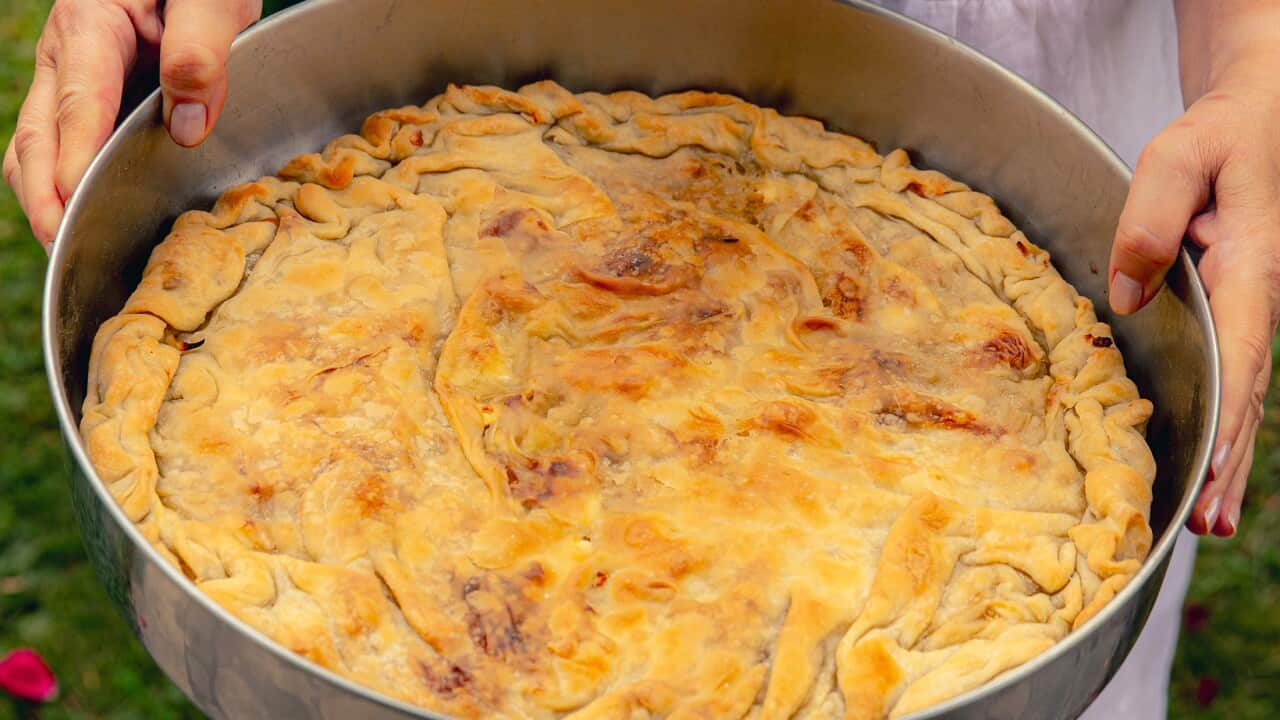makes
2 sheets
prep
15 minutes
difficulty
Mid
makes
2 sheets
serves
preparation
15
minutes
difficulty
Mid
level
Ingredients
- 500 g (1 lb 2 oz/3⅓ cups) plain (all‑purpose) flour
- 1 tsp salt
- 60 ml (2 fl oz/¼ cup) olive oil, plus extra for brushing
- 1 tbsp white wine vinegar
- 250 ml (8½ fl oz/1 cup) lukewarm water
- cornflour (cornstarch), for dusting
Instructions
- Put the flour and salt in a bowl, make a well in the centre and pour in the olive oil and vinegar. Start adding the lukewarm water a little at a time and mix with either a spoon or your hands until it resembles a soft dough. You may not need all the water or you may need more.
- Tip the dough onto a lightly floured bench and knead lightly until smooth, about 6 minutes. Place it back into the bowl and cover with a tea towel (dish towel). Let it rest while you make the filling for your recipe (such as kremmydopita, a caramelised onion and feta pie).
- Lightly brush a 36 cm (14 in) round baking tin with olive oil and set aside.
- Place the dough back on your bench and divide into six equal balls. Take one ball of dough and roll it out to the size of a round dinner plate. Brush with some olive oil and set aside. Roll out another piece of dough to the same size and place it on top of the oiled piece, then brush the top of it with oil. Repeat with another piece of dough so you have three oiled rounds; these three balls of dough will roll out into one large filo sheet. Repeat with the three remaining balls of dough so you have two layered rounds of dough ready to roll out.
- Using a thin rolling pin called a plasti, which is about 2 cm (¾ in) in diameter (if you don’t have a plasti then a regular rolling pin will do, but the closer to this size the better), roll out one layered pile of rounds to the size of the baking tin plus a bit extra, making sure you have enough to cover the sides as well. Place this into your oiled tin.
- Pour in the filling and spread evenly.
- Repeat the rolling of the pastry with the remaining layered pile of dough rounds and use this thin piece to cover the filling. Fold the edges of the bottom pastry layer over the top layer, twisting or pinching the edges together to seal the filling inside. Brush the top with olive oil and bake for about 1 hour or until it is crispy and golden.
- Allow to cool, cut into pieces and serve.
Notes
- Filo plays a vital role in the traditional dishes of northern Greece. It is used in many savoury pies (pites) filled with cheese, meat or vegetables, and in sweets such as the popular baklava, a rich dessert made of layered filo, nuts and honey. It is an everyday staple as well as a food for festivals and celebrations in regional cuisine. The process of making filo is often an activity involving family members and friends, reinforcing social bonds. My most treasured memories of making filo are with my mother in her kitchen.
- This file recipe makes a flexible pastry that works well for savoury pies. Store-bought filo (usually available frozen) is thinner and drier, so it becomes super crispy when baked. It is perfect for sweets like saragli [Greek rolled baklava] where you’re after a crunchier texture. However, if you are short of time, you can also use store-bought filo for savoury pies.
This is an edited extract from Thessoloniki by Meni Vale (Hardie Grant Books). Photography by Stephanie Stamatis.
Cook's Notes
Oven temperatures are for conventional; if using fan-forced (convection), reduce the temperature by 20˚C. | We use Australian tablespoons and cups: 1 teaspoon equals 5 ml; 1 tablespoon equals 20 ml; 1 cup equals 250 ml. | All herbs are fresh (unless specified) and cups are lightly packed. | All vegetables are medium size and peeled, unless specified. | All eggs are 55-60 g, unless specified.

